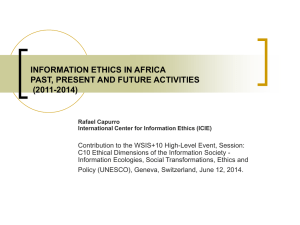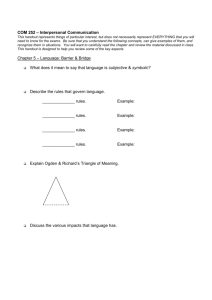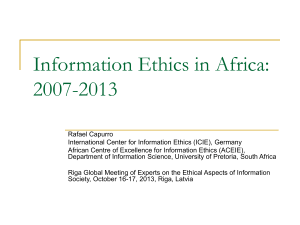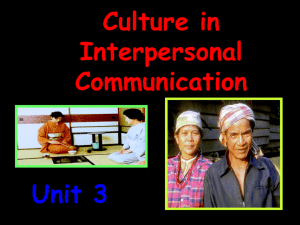Cross-Cultural Marketing
advertisement
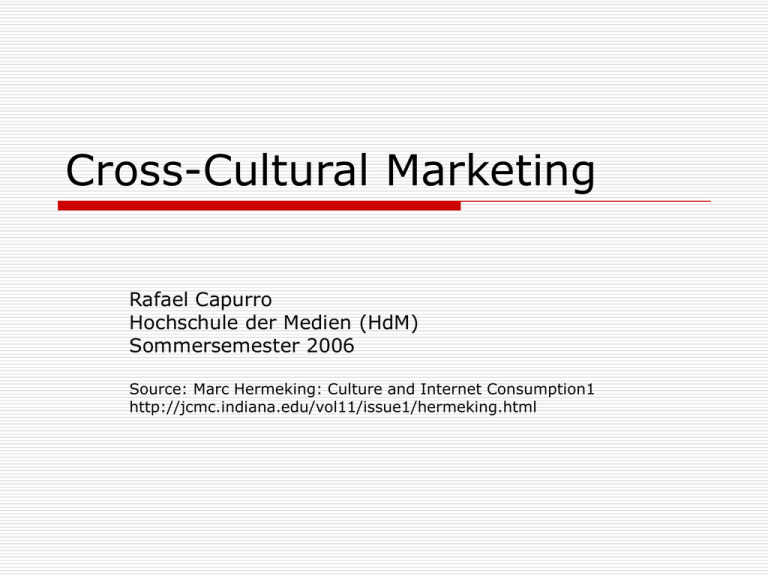
Cross-Cultural Marketing Rafael Capurro Hochschule der Medien (HdM) Sommersemester 2006 Source: Marc Hermeking: Culture and Internet Consumption1 http://jcmc.indiana.edu/vol11/issue1/hermeking.html Introduction Culture-free products: like ICT Culture-bound products: like food (difficult/non difficult to standardize) -> The latter notion needs to be revised because tecnical systems are subject to cultural influences. R. Capurro: Vorlesung Interkulturelle Websiteforschung 2 1. Cultural Differences in the Consumtion of the Internet The Internet as a product of ICT is a marketable good. The Internet is a new channel of communication through which marketing communication can be spread. R. Capurro: Vorlesung Interkulturelle Websiteforschung 3 1. Cultural differences… Consumption research is an essential precondition for appropriate product design. Try to uncover how much, by whom, where, at what time, for what purpose, and according to whose preferences the Internet is used and how it is used R. Capurro: Vorlesung Interkulturelle Websiteforschung 4 1. Cultural differences… The Worldwide Disparity 2000: most Internet users in USA (147 Mio), followed by Europe (91 Mio) and Asia Pacific Basin (75 Mio). 2005: USA (48%), Canada & Australia (46%), Germany (36%)…-> Digital Divide. Cultures with low Uncertainty Avoidance are more open to the Internet as new medium of communication. R. Capurro: Vorlesung Interkulturelle Websiteforschung 5 1. Cultural differences… The correlation with low Uncertainty Avoidance was weakened by high rates of literacy and international trade – but not by a high economic development. Individualism as a (positive) correlation for Internet use. R. Capurro: Vorlesung Interkulturelle Websiteforschung 6 1. Cultural differences… Role of Cultural Communication Styles: Individualistic cultures (egalitarian, democratic nature of the Internet) High/low-context communication (Hall): shared vs. transmitted information High Individualism -> low-context (explicit, direct, formal, written) (Swiss, Germans, Scandinavians, Anglo-Americans, English) Collectivism -> high-context (implicit, informal, symbolic, pictures) (Japanese, Arabs, Latin American, Italian-Spanish, French) R. Capurro: Vorlesung Interkulturelle Websiteforschung 7 1. Cultural Differences… High-context cultures: Indirect and transformational advertising messages creating emotions through pictures and entertainment (France, Japan) Low-context cultures: direct and rational advertising messages providing product information (Germany, USA) R. Capurro: Vorlesung Interkulturelle Websiteforschung 8 2. Implied Cultural Concepts Cateora‘s model of the international marketing environment „uncontrollables“ (legislation, politics, economy, topographic facts, infrastructure, standards of technology…) „controllables“ (marketing strategies and instruments) But: this model is based on the concept of national culture (as Hofstede‘s) R. Capurro: Vorlesung Interkulturelle Websiteforschung 9 2. Implied… Hofstede‘s model is based on five cultural dimensions (80 countries): Hierarchy Group orientation (Individualism) Gender Roles (Masculinity) Trust Risk-taking (Uncertainty Avoidance) R. Capurro: Vorlesung Interkulturelle Websiteforschung 10 2. Implied… Hall‘s model (only a few countries are mentioned): High- vs. Low Context (shared vs. Transmitted information) Explicit vs. Indirect communication style (formal/informal, written/symbolic) R. Capurro: Vorlesung Interkulturelle Websiteforschung 11 3. Cultural Influences on Website Design Site Quality (usability) Establishment of trust Creation of positive effect during website use -> more trust correlates to culturallyfamiliar communication style R. Capurro: Vorlesung Interkulturelle Websiteforschung 12 3. Cultural influences… Culture-related design criteria: Correlation between content appeal and layout: Layout: written text -> information/rational i.e. low-context communication Layout: visual picture -> entertainment/emotional, i.e. high-context communication R. Capurro: Vorlesung Interkulturelle Websiteforschung 13 3. Cultural influences… Structural design criteria: Content appeal Layout Length of pages Multimedia presentation Interactivity Structure of content Total volume of website Degree of navigation support R. Capurro: Vorlesung Interkulturelle Websiteforschung 14 4. Some general findings Websites of global companies tend to be strongly standardized dominated by rational content appeals text-heavy layout presenting small pictures only Low multimedia presentation High interactivity Large website volume Deeply structured content Intensive navigation support R. Capurro: Vorlesung Interkulturelle Websiteforschung 15 4. Some general… Amazon Homepages: High-context: France www.amazon.fr Low-context: Germany www.amazon.de R. Capurro: Vorlesung Interkulturelle Websiteforschung 16 4. Some general R. Capurro: Vorlesung Interkulturelle Websiteforschung 17 4. Some general… R. Capurro: Vorlesung Interkulturelle Websiteforschung 18 4. Some general… In the Old Economy, websites of companies representig industrial goods and primarily adressing business users (B2B) tend to be standardized to a similar degree. ABB UK and ABB France R. Capurro: Vorlesung Interkulturelle Websiteforschung 19 4. Some general… R. Capurro: Vorlesung Interkulturelle Websiteforschung 20 4. Some general… R. Capurro: Vorlesung Interkulturelle Websiteforschung 21 4. Some general… The general nature of these websites corresponds to Low-context (explicit) communication Monochronic (linear) time orientation R. Capurro: Vorlesung Interkulturelle Websiteforschung 22 4. Some general… Websites that address consumers (B2C) reveal different tendencies: High-interest (durble) products: modest standardization High-context (indirect) cultures exhibit a higher degree of cultural adaptation, more colored backgrounds, larger pictures, animated illustrations R. Capurro: Vorlesung Interkulturelle Websiteforschung 23 4. Some general… Multimodality tends to be higher in highcontext (symbolic) cultures Navigation support tends to be less intensive in high-context (symbolic) cultures (frequent use of icons) -> for instance: Sony USA (low-context) vs. Sony Japan (high-context) R. Capurro: Vorlesung Interkulturelle Websiteforschung 24 4. Some general… R. Capurro: Vorlesung Interkulturelle Websiteforschung 25 4. Some general… R. Capurro: Vorlesung Interkulturelle Websiteforschung 26 4. Some general… Websites representing global brands of non-durable, low-interest products reveal a higher degree of cultural adaptation. -> Coca Cola USA / Coca Cola Italy See Okazaki (2005): Analysis of 206 homages of US companies in four European countries (durable/nondurable products) R. Capurro: Vorlesung Interkulturelle Websiteforschung 27 4. Some general… R. Capurro: Vorlesung Interkulturelle Websiteforschung 28 4. Some general… R. Capurro: Vorlesung Interkulturelle Websiteforschung 29 4. Some general… Local websites of global consumer brands occasionally seem to be more standardized worldwide. See websites of French food brand (tend to represent high-context (implicit) style Websites of German car brand (tend to represent low-context (explicit) style (Mercedes-Benz in Italy, Lancia in Germany) R. Capurro: Vorlesung Interkulturelle Websiteforschung 30 4. Some general… R. Capurro: Vorlesung Interkulturelle Websiteforschung 31 4. Some general… R. Capurro: Vorlesung Interkulturelle Websiteforschung 32 4. Some general… The „country-of-origin“ effect is difficult to achieve successfully: it works only in case the images of the product are positively related in the targeted countries (otherwise trust is created by culture-specific adaptations) R. Capurro: Vorlesung Interkulturelle Websiteforschung 33 4. Some results… Verbal headlines or slogans differ quite the same respect Other linguistic aspects (like the use of „we“, logical styles, forms of rational expression…) could provide for additional cues for cultural adaptation. R. Capurro: Vorlesung Interkulturelle Websiteforschung 34 4. Some results… Degree of website adaptation with respect to the represented product: B2B: low-context (explicit, written): ABB (industrial goods) B2C: high(er) adaptation: durables (Sony), non-durables (Coca-Cola) R. Capurro: Vorlesung Interkulturelle Websiteforschung 35 4. Some results… Too many websites are still characterized by a dominant lowcontext (rational, text-heavy) style A country‘s low rate of Internet consumption could be considered as a general indicator for low quota of culturally appropriate websites. R. Capurro: Vorlesung Interkulturelle Websiteforschung 36
